April 8, 2022
Air Date: April 8, 2022
FULL SHOW
SEGMENTS
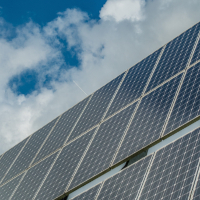
Shutdowns in the Solar Industry
View the page for this story
Much of the US solar energy installation business has been frozen suddenly in its tracks by a U.S. Department of Commerce investigation into whether China is evading tariffs on solar cells and panels. So at a time when there is more demand than ever for solar power, the U.S. solar installation industry is now experiencing project delays, layoffs, and uncertainty. Host Steve Curwood talks to Abigail Hopper, CEO of the Solar Energy Industries Association and George Hershman, CEO of SOLV Energy, about the chilling effect and consequences of these tariffs and the investigation. (08:31)
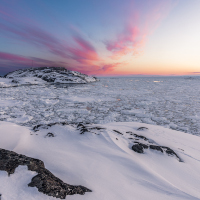
Beyond the Headlines
/ Peter DykstraView the page for this story
On this week's trip beyond the headlines, Host Jenni Doering is joined by Environmental Health News' Weekend Editor Peter Dykstra. First, the two discuss the methane-rich melting permafrost under the Arctic Ocean. Then, they take a look at a killer parasite wiping out an invasive ant species in Texas. And finally, a peek through the history books at the Teapot Dome scandal, 100 years ago. (04:43)
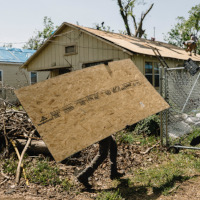
Troubles for Climate Disaster Resilience Workers
View the page for this story
As climate related disasters worsen, the people who help rebuild cities afterwards are more vital than ever. But advocates say too many of these “resilience workers” are underpaid, overworked, and lack the resources they need to be safe in hazardous working conditions. Co-host Jenni Doering shares with Host Steve Curwood the story of Joel Salazar, a former reconstruction worker who now works as a field organizer for the nonprofit Resilience Force. (05:13)

The Climate Resilience Workforce Act
View the page for this story
Democratic Representative Pramila Jayapal of Washington State recently introduced the Climate Resilience Workforce Act, which aims to protect disaster recovery workers, grow the workforce, and prioritize the communities most in need of federal assistance when climate disasters strike. Saket Soni is the Executive Director of Resilience Force and helped draft the bill. He joins Host Jenni Doering to discuss. (08:35)

BirdNote®: The Sociable Weaver’s Colonial Nest
/ Michael SteinView the page for this story
What if birds lived in giant apartment complexes? Meet the sociable weaver from Africa’s arid plains, a species that does just that. As BirdNote®’s Michael Stein explains, these creatures build fascinating multi-unit nests that can house up to 500 birds. (02:02)
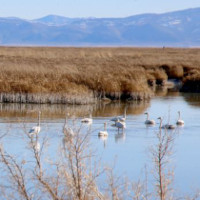
Draining Summer Lake
/ Emily CuretonView the page for this story
Oregon's Summer Lake Wildlife Area has protections in place for the land, but not for the water. Under the current water rights, the springs that feed this critical migratory bird habitat could dry up within a generation. Emily Cureton Cook reports on Summer Lake for Oregon Public Broadcasting. (04:36)
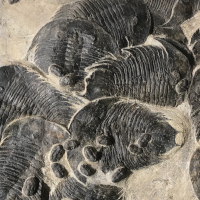
‘Dear Specimen’: Poetry for the Extinction Crisis
View the page for this story
For poetry month, a look at a collection of poems that peer deep into the past at species long gone to grapple with the extinctions unfolding today. Poet W. J. Herbert joins Host Steve Curwood to read poems from her “Dear Specimen” collection and explore the role of poetry in revealing and consoling our anxieties about the climate and extinction crises. (13:49)
Show Credits and Funders
Show Transcript
220408 Transcript
HOSTS: Steve Curwood, Jenni Doering
GUESTS: George Hershman, W.J. Herbert, Abigail Hopper, Joel Salazar, Saket Soni
REPORTERS: Emily Cureton Cook, Peter Dykstra, Michael Stein
[THEME]
CURWOOD: From PRX – this is Living On Earth.
[THEME]
CURWOOD: I’m Steve Curwood.
DOERING: And I’m Jenni Doering.
China is accused of avoiding U.S tariffs on solar panels by making them in neighboring countries.
HERSHMAN: The consequences for this are extremely dire for the for the industry. Currently, about 80% of the modules that are used in the US installations come from the countries that have been named in this petition.
CURWOOD: Also, how a Climate Resilience Workforce Act could help disaster recovery.
SONI: The resilience workforce is doing it's work now but it's hanging by a thread. It's not paid enough, and it's not big enough so what this bill will do is protect the current workforce with labor standards but it will also add millions of jobs to this workforce.
CURWOOD: That and more this week on Living on Earth – Stick Around!
[NEWSBREAK MUSIC: Boards Of Canada “Zoetrope” from “In A Beautiful Place Out In The Country” (Warp Records 2000)]
[THEME]
Shutdowns in the Solar Industry
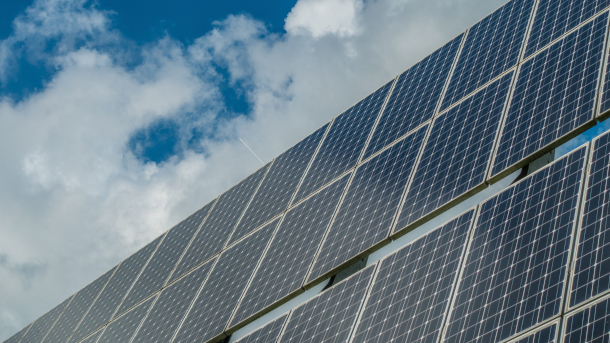
SOLV Energy’s main projects can produce 200 Megawatts of energy, around the equivalent yield of a small coal plant. (Photo: Piqsels, public domain)
DOERING: From PRX and the Jennifer and Ted Stanley Studios at the University of Massachusetts Boston, this is Living on Earth. I’m Jenni Doering.
CURWOOD: And I’m Steve Curwood.
The US solar energy installation business has been frozen suddenly in its tracks by a complaint to the US Department of Commerce that China is evading tariffs on solar cells and panels. At the same time there is more demand for solar power, as the war in Ukraine disrupts fossil fuel supplies and climate change worsens. Back in 2011 the Commerce Department did find that China was selling solar panels to the US at prices below the cost of manufacture, a practice known as dumping. China backed off of the subsidies involved, but then in 2018 the Trump administration-imposed tariffs on Chinese solar panels as part of a larger trade war. And on April first the Commerce Department began an investigation into charges Chinese companies are circumventing these tariffs by completing manufacturing in Southeast Asian countries. With possible retroactive penalties for imports, the U.S. solar industry is already seeing project delays. The vast majority of solar panels now come from Asia. And experts say even at warp speed it would take at least two years before enough panels could be made in the US to meet President Biden’s goal of using domestic manufacturing to drive clean energy growth. Abigail Hopper is CEO and President of the Solar Energy Industries Association. I asked her to comment on the complaint that Chinese companies are somehow bypassing US tariffs.
HOPPER: The claims that are being made is that Chinese companies are getting around US trade law by putting manufacturing facilities in countries other than China. It is our strong belief and our legal position that that is not what is happening. But that is the crux of the investigation.
CURWOOD: As I understand some folks say, well, Chinese companies are having folks in Vietnam or Malaysia or other places in Southeast Asia, do the final assembly or maybe even just stick the label on before it gets shipped to the United States. How fair is that characterization?
HOPPER: Yeah, I think it's a very unfair characterization of what's happening. There is significant and major manufacturing processes. And I use those words very intentionally, because those are the words in the statute. So there are some raw materials coming out of China. But the vast majority of the value of the product is being produced in countries like Vietnam, Thailand, Malaysia, and then they're being shipped to United States. It is a perfectly permissible way in which our goods enter the United States.
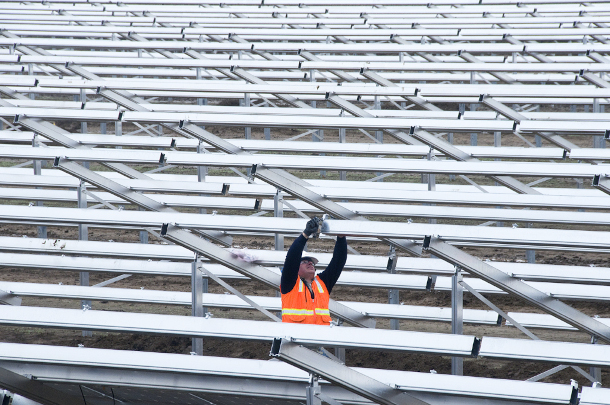
One utility-scale solar power project can employ 300-400 people, Hershman says. With the delays produced by the investigation, not only are existing workers being laid off—new workers aren’t being hired, most of whom would come from rural areas. (Photo: Oregon Department of Transportation, Flickr, CC BY 2.0)
CURWOOD: To what extent is this a new practice of China completing the manufacturing of products in other Southeast Asian countries?
HOPPER: You know, this isn't really a new practice, there have been tariffs on cells and modules coming out of China since the early 2010s. It's one thing if you're good, you figured out a smarter way, a more efficient way to manufacture a product, that's competition. But if your government gives you unfair advantage, then that's not fair competition. And that's what the Department of Commerce found in the early 2010s. What has happened in the ensuing period is that some companies have made investments in other countries in Southeast Asia, choosing to invest in other countries is what happens all the time around the world. You know, I'm holding an iPhone in my hand as we're talking. I have a dress on. There's a global marketplace that we're talking about. And these companies are abiding by the laws we have set and this investigation threatens to have a detrimental impact on our industry.
CURWOOD: Abigail Hopper is CEO of the Solar Energy Industries Association. For a view from the frontlines of the US solar industry, we called George Hershman, CEO of SOLV Energy, which builds utility scale solar power stations.
HERSHMAN: The consequences for this are extremely dire for the industry. Currently, about 80% of the modules that are used in the US installations come from the countries that have been named in this petition. So currently, we have really no access to modules, module manufacturers are not delivering to the US, which is essentially frozen the market today. You know, to date, we are either shifting employees to projects that currently have modules to install, you know, we're going to see layoffs in the next 30 or 60 days, if we continue down this path. The number that often doesn't get counted is the amount of new hires that we won't be making. A typical project for us is about 200 megawatts, we'll hire somewhere between three and 400 people, most of our projects are in rural areas, if a project is delayed, we are not hiring three or 400 people.
CURWOOD: Now, what is the demand for photovoltaic solar arrays in this country? And to what extent can US manufacturers meet that demand.
HERSHMAN: So there is a massive demand for renewables in all sectors. So there's really three distinct parts of the industry. There's a residential sector that is putting panels on rooftops, and there's a massive demand because of energy challenges due to natural disaster or wildfire. There's a commercial sector, that's the areas that serve corporate offices, schools, municipal buildings. And then a sector that we specialize in, which is the utility sector, which is the largest part of the industry and has huge demand in almost all states of the kind of lower 48 now are dealing with the need for renewables. Solar has been the lowest cost of energy generation for a number of years in a number of areas, the US capacity currently just doesn't meet probably 10% of the overall demand. And most of the product that is built here, services, the residential and commercial sector, our product just doesn't exist in the US. So it's not like we can go buy enough product to build one of our projects, let alone 30 projects that we have under construction. Now, obviously, the hope is that through true industrial policy, something like the manufacturing tax credits that we see within what was Build Back Better, and hopefully will come back in some form of at least a renewable energy bill. And we look forward to that, we want to buy us product, it just currently doesn't exist today.
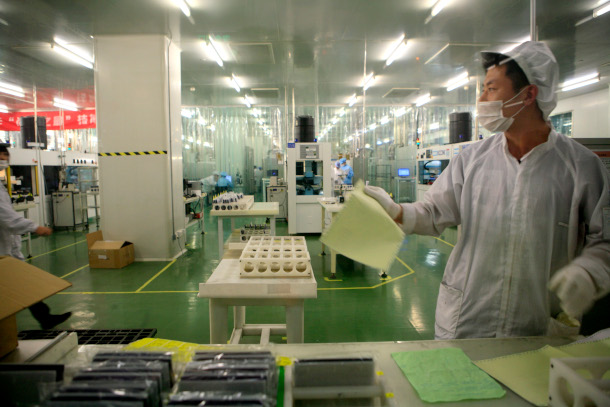
China is the largest manufacturer of solar panels in the world. The U.S. imports 80% of its solar equipment from Chinese manufacturing companies. (Photo: Jiri Rezac, Climate Group, Flickr, CC BY-NC-SA 2.0)
CURWOOD: To what extent does protectionism around solar reflect the interests of the fossil fuel industry?
HERSHMAN: Well, clearly anything that slows down the adoption of renewables continues to support the use of fossil fuels. And we should be doing everything we can to expand deployment, and we have an administration that is supportive of that, at least in their words. Unfortunately, what we've seen is a continuation of a previous administration's tariffs and this new action that has really countered to the administration's goals.
CURWOOD: In your view, what does President Biden need to do to get serious about the climate at least visa-à-vis the production of solar power?
HERSHMAN: Well, I hope that President Biden recognizes that we need to support US industry. Unfortunately, there are certain companies that are using the tariff laws to their advantage and essentially weaponizing them for their own gain. The administration needs to recognize that you can't let small fringe players up end the entire agenda. And so I'm hoping that the administration will review this case quickly. There is no reason to take the required 150 days, they can recognize that there is no new information in this petition that's already been determined in previous ABC VD cases and throw it out quickly.
CURWOOD: George Hershman is the chief executive of SOLV Energy. Thank you so much for taking the time with us today.
HERSHMAN: Oh, thank you for having me. I really appreciate it.
CURWOOD: We reached out for comment to the US Department of Commerce as well as the office of the US Trade Representative in the White House, but neither office responded before our production deadline.
Related links:
- Los Angeles Times | A Commerce Department investigation could imperil the solar industry, advocates say
- George Hershman’s Twitter
- Abigail Hopper’s Profile
- SEIA’s report on the investigation
- Financial Times’s reporting on the investigation
[MUSIC: Tarika, “Bon Annee” on D, by Tarika]
Beyond the Headlines
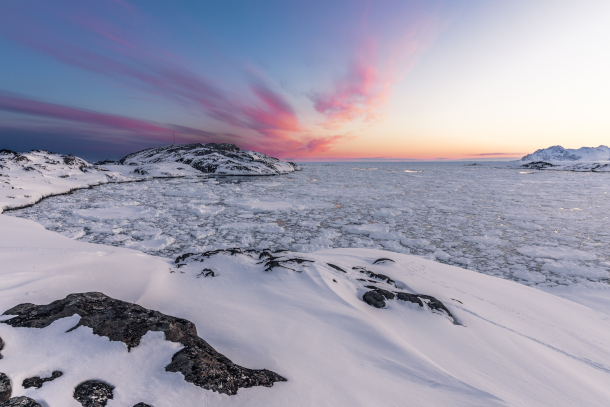
Portions of permafrost under the Arctic Ocean are melting, just like much permafrost found on land. (Photo: Markus Trienke, Flickr, CC BY_SA 2.0)
DOERING: It's that time of the broadcast now for a look beyond the headlines with Peter Dykstra. Peter's an editor with Environmental Health News. That's EHN.org and DailyClimate.org. And he joins us from Atlanta, Georgia. Hey, Peter, how you doing this week?
DYKSTRA: Hi, Jenni. I'm doing okay. But we've got a couple of weird, unheard of stories to start us off. First of all, everyone who's followed climate change knows about melting permafrost and how that can release methane, and be kind of a supercharger for climate change in the Arctic. I hadn't known about thawing permafrost from under the Arctic Ocean.
DOERING: Yeah, we've seen these sinkholes in Siberia. But this is actually under the sea floor.
DYKSTRA: That's right. There's a report that came out recently in the Proceedings of the National Academy of Sciences, in which an international team looked at the ocean floor, and saw that off of northern Canada, detected by sonar, are the possible release of large amounts of methane, as the permafrost under the ocean melts just like it does under the land.
DOERING: I guess it's fair to say that what happens up there with the permafrost could really shape the kind of climate warming that we experience.
DYKSTRA: It's fair to say, and it also underscores how little we know about what may be bad, what may be worse, what can be somehow mitigated and what's not so bad. But it's one more thing to think about in an area where we already have plenty to think about.
DOERING: Indeed. Well, I hope that this next story doesn't give us another thing to worry about, Peter.
DYKSTRA: How about a killer parasite? But it's a killer parasite that may end up doing a good thing; that is, going after another killer parasite, in a classic case, of the enemy of our enemy is our friend. And we're talking about an animal, this is it's real name. It's called the tawny crazy ant, native of South America. They've shown up in Texas, and it's beginning to destroy colonies of native ant species. It's also going after other animals like baby birds, some baby reptiles. And what they do is they form super colonies that tend to help each other rather than compete with each other. And they are showing up in Texas at an alarming rate. But so is another parasite that's going after the tawny crazy ants.
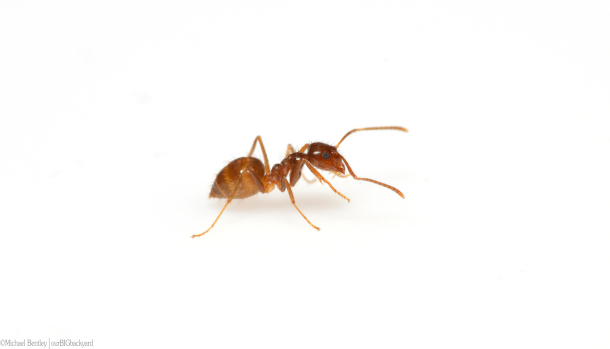
Tawny crazy ants are an invasive species in Texas. (Photo: Michael Bentley, Wikimedia Commons, CC BY-SA 4.0)
DOERING: Yeah, I really didn't think that a killer parasite would be good news, Peter, but tell me more.
DYKSTRA: There's a microsporidian fungus-like parasite. It's new, it's a new genus, it's a new species, that scientists are just learning a lot about. It's ruining the day of crazy ants by bloating their bellies, and hopefully lessening their threat to the native species of Texas and elsewhere.
DOERING: Hmm, well, what do you have in the history books this week?
DYKSTRA: Yes, we've got an oil scandal celebrating its 100th birthday. April 7, 1922. A big oil man in the first half of the 20th century named Harry F. Sinclair, acquired exclusive rights to the US Navy's oil holdings at Teapot Dome in Wyoming. It became known as the Teapot Dome Scandal. It was a sweetheart deal with the Interior Secretary Albert Fall. Fall was convicted of related charges. spent a year in jail. Sinclair spent six and a half months in jail for contempt. And it began what's become a long and storied history of oil scandals, starting 100 years ago, this past week.
DOERING: Yeah, you know, I'm glad you bring this up. Because I remember that I was supposed to learn about the Teapot Dome scandal in AP Gov. And I don't think it really stuck with me. So I'm glad for the history lesson, Peter.
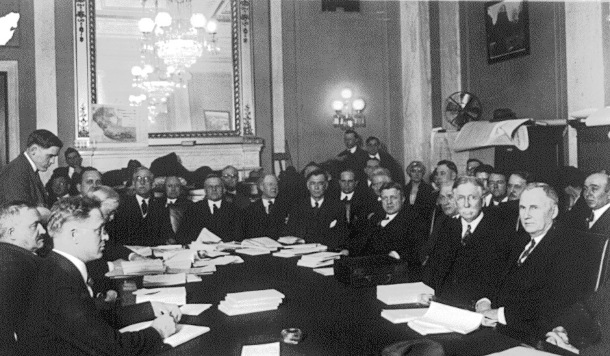
Oil businessman Edward L. Doheny (at table, second from right) testifies before the Senate committee investigating the Teapot Dome oil leases. (Photo: National Photo Company Collection, Wikimedia Commons, Public Domain)
DYKSTRA: Well, if it didn't take in your high school US history lessons, fate has guided you to hosting Living on Earth and this segment about Teapot Dome, 100 years after the fact.
DOERING: And here we are. Peter Dykstra is an editor with Environmental Health News. That's EHN.org and DailyClimate.org. And thanks a lot, Peter, as always, we'll talk to you again next week.
DYKSTRA: All right, Jenni. Thanks a lot. Talk to you soon.
DOERING: And there's more on these stories at the Living on Earth website. That's LOE.org.
Related links:
- Undark Magazine | “Under the Sea, a Hidden Climate Variable: Thawing Permafrost”
- Wired | “A Killer Parasite Is Wiping Out Hordes of Ants—in a Good Way”
- Read more on the Teapot Dome Scandal
[MUSIC: Shemekia Copeland, “Smoked Ham and Peaches” on America’s Child, by Joh Hahn, Alligator Records & Artis Management]
DOERING: Coming up – A proposal in Congress to protect the workers who help communities with climate resilience and reconstruction after disasters. That’s just ahead on Living on Earth.
ANNOUNCER: Support for Living on Earth comes from Sailors for the Sea and Oceana. Helping boaters race clean, sail green and protect the seas they love. More information @sailorsforthesea.org. Support also comes from Friends of Smeagull the Seagull and Smeagull’s Guide to Wildlife. It’s all about the wildlife right next door to you! That’s Smeagull, S - M - E - A - G - U - L - L, SmeagullGuide.org.
[CUTAWAY MUSIC: Daniel Estrem, “While My Guitar Weeps” http//:magnatune.com, by George Harrison]
Troubles for Climate Disaster Resilience Workers
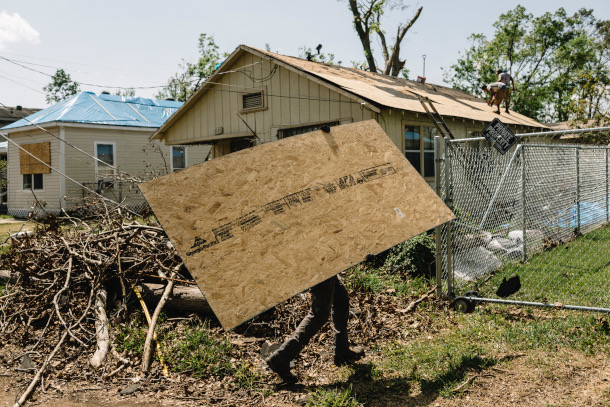
Resilience workers find themselves on the front lines of climate change reconstruction. The image above features damaged homes after Hurricane Laura swept through the Lake Charles, Louisiana area. (Photo: Courtesy of Resilience Force)
CURWOOD: It’s Living on Earth, I’m Steve Curwood.
And I’m Jenni Doering
NEWS TAPE: Right now we are looking at the imminent landfall of this storm. Winds of 150 miles per hour. Storm surges up to 15 to 16 feet, 20 inches of rain or more with this system.
DOERING: The scenes of devastation brought by disasters like Hurricane Ida in 2021 quickly fade from our news feeds after just a few short days. But, Steve, as you know the hard work of rebuilding lasts a lot longer.
CURWOOD: Right Jenni, it takes many months and even years to clean up from disasters like that, and we’re seeing more and more of them with climate disruption.
DOERING: Yeah we sure are. Well, many of the people doing that work belong to a group called resilience workers. They’re often low-paid immigrants, sometimes undocumented, who travel across the U.S. from disaster to disaster rebuilding communities, kind of like how agricultural workers follow seasonal crops. Advocates say they’re the unsung heroes of rebuilding our country from the ravages of climate change but that they’re often being exploited. These advocates say these workers are overworked, underpaid, and not given the resources they need to be safe.
CURWOOD: Oh my, I understand you recently connected with one of these resilience workers.
DOERING: That’s right, Joel Salazar got started with this kind of work right after he moved to the United States from Venezuela 5 years ago.
SALAZAR [W/ VOICEOVER]: I arrived in Panama City Beach after hurricane Michael, a category 5 hurricane that completely destroyed that city. Then I became involved in reconstructing local communities.
DOERING: Joel was doing heroic work but it was often dangerous and traumatic.
SALAZAR: The most difficult part is seeing how a hurricane or a fire has destroyed millions of homes. And watching first hand how climate change impacts daily life. When I see that horrible level of destruction, I am afraid because I’m not sure what I may face. I may be electrocuted, I may find the body of a person or come in contact with chemicals. And a lot of us are not prepared or equipped for this work that we must face. So that saddens me because we risk our lives so communities can rebuild and people can go back to their homes and continue on with their lives.
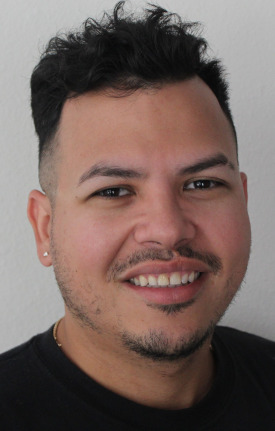
Joel Salazar is a field organizer for Resilience Force. (Photo: Courtesy of Joel Salazar)
DOERING: And because thousands of these workers are in vulnerable positions as immigrants, they often have no choice but to accept the low pay a contractor offers, if they get paid at all. And that’s how Joel says he was taken advantage of.
SALAZAR: I was a victim of labor exploitation, of labor fraud. I wasn’t compensated.
CURWOOD: That’s horrible. Jenni, what about labor standards, what kind of protections are in place for these resilience workers?
DOERING: That’s the thing, federal aid dollars are currently doled out without specifying basic labor protections like a minimum wage, overtime pay and safer working conditions. Joel’s trying to help fill that gap and he now works as an organizer for Resilience Force, a nonprofit aimed at strengthening and securing America’s Resilience workforce. Part of his job involves protecting resilience workers from the injustice he experienced.
SALAZAR: As field organizers, we visit the centers where these workers meet and we try to provide support. A lot of the time they are alone, they arrive in the United States by themselves and they can’t count on anyone for support. I’ve also seen that once the cleanup is over, resilience workers are kicked out of cities or immigration picks them up. So, it’s very sad to see how a lot of us leave a stable life to travel and reconstruct communities, and then after the work is done we are set aside and abandoned.
DOERING: And Steve, the lack of basic labor protections and access to healthcare can lead to tragedy. Like in the case of David Martinez, a reconstruction worker Joel Salazar knew personally.
SALAZAR: Today we got an early call. One of the resilience workers we work with was found in a public area, he was found dead. Probably because of some sort of illness. Unfortunately, a lot of resilience workers don’t have healthcare, they can’t go to a hospital. And often times they end up dying in the worst way. And that news today impacted all of us who work as field organizers. It’s really hard to see how this young man did not receive the full support he needed. Just like him there are a lot of resilience workers who don’t have any support. That’s why this organization exists to say “hey, I’ve been in your shoes this is what you can do”. So we are trying to provide the maximum support we can to change this industry.
CURWOOD: Wow, that’s such a heartbreaking story.
DOERING: It is. But there is a glimmer of hope.
Related links:
- The New Yorker | ”The Migrant Workers Who Follow Climate Disasters”
- Hear the following story about the Climate Resilience Workforce Act
- About Resilience Force
The Climate Resilience Workforce Act
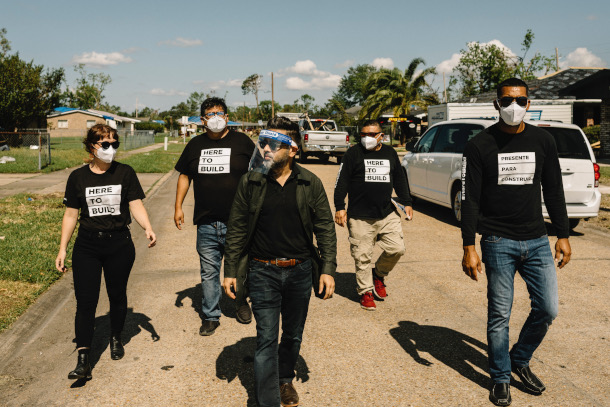
Saket Soni (third to the right) is a labor organizer and human rights strategist. He is founder and director of Resilience Force, a national initiative to transform America’s response to natural disasters by strengthening and securing America’s resilience workforce. (Photo: Courtesy of Resilience Force)
DOERING: A new bill in Congress aims to protect disaster recovery workers and create jobs. The Climate Resilience Workforce Act was introduced in the House in February by Democratic Representative Pramila Jayapal of Washington State. There haven’t been any hearings on the bill yet but the goal is to establish a $15 minimum wage and ensure healthcare coverage. And it will prioritize the communities most in need of federal assistance when climate disasters strike. It also addresses the rising costs of recovery. In 2021 alone there were 20 separate climate related disasters that each exceeded $1 billion dollars in losses each. Saket Soni is the Executive Director of Resilience force and helped draft the Climate Resilience Workforce Act.
SONI: What this bill will do is protect the current workers with labor standards, health and safety standards, but it'll also add millions of jobs to this workforce. It'll spend money, send it to cities, states and tribal governments and help them build their own resilience workforce locally, adding lots and lots of people to this workforce and setting them up for long term careers.

Blue tarp is often used after storm damage because it provides a temporary covering to help reduce further damage to property until permanent repairs can be made. Some homeowners and landlords are eligible for Operation Blue Roof, a program offered by FEMA through the U.S. Army Corps of Engineers. (Photo: Courtesy of Resilience Force)
DOERING: I think you mentioned millions of jobs. These workers can come in when there is a disaster, and they can help rebuild a community. And to what extent could they also help implement climate adaptation, you know, not just rebuilding the same way as before, but rebuilding better and maybe even weatherizing homes and other things like that on a longer term basis?
SONI: Well, absolutely, that's a huge part of the need. And I think that's a big part of the intention of representative Jayapal's Climate Resilience Workforce Act. Congress has already passed a trillion dollars over 10 years to be spent on infrastructure that can include and should include not just money for bridges and roads, but for climate adaptation, and climate resilience. A lot of that money should actually go to West Virginia, where Senator Manchin has a state that experiences flooding year after year, historic flooding, you know, homeowners are in a constant crisis. You can imagine people who transition out of the coal industry, getting good high paying jobs, doing climate adaptation work right in West Virginia, and across the country. So what you could actually have is something akin to what already exists in New Orleans.
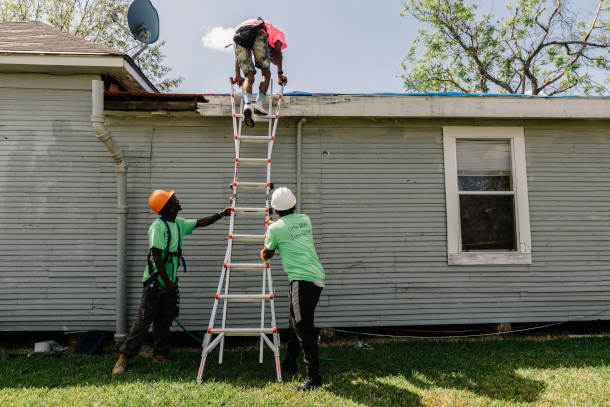
Reconstruction workers climbed a ladder onto a roof after it was damaged from storm damage from the 2020 Hurricane Laura in the Lake Charles Area. (Photo: Courtesy of Resilience Force)
In New Orleans, the mayor has created a resilient score, taking people who lost their jobs during the pandemic in the service sector, and turning them into a permanent core of resilience workers who are working on adaptation, both in relation to climate change, and the pandemic. These are workers who used to earn $7.25 an hour, the federal minimum wage, and are now on a path to $18 an hour doing this kind of work. So, you know, these are good long term jobs. The idea that you need to build back better, actually, isn't an idea of Congress. It's something that most homeowners would agree on. Most people in the United States know that their roofs were constructed 15, 20 years ago. And they actually need not just restoration, but a much stronger home to face the next season's hurricanes, floods and fires. So you can imagine, you know, skilled armies of workers who do climate adaptation work in American cities, and in rural areas, year after year.
DOERING: So early on, in his term, President Biden put forth the justice 40 initiative pledging to direct 40% of climate spending to underserved places, including communities of color and small towns. How fairly has disaster recovery funding been allocated historically? And how would the Climate Resilience Workforce Act remedy this?
Whether it's hurricanes, tornados, or fire, we're ready to meet the challenges that disasters pose and help communities recover.
— Resilience Force (@ResilienceForce) April 7, 2022
From California to the Gulf Coast, Resilience Workers are #HereToBuild. pic.twitter.com/HqdWDtDOJi
SONI: Disaster recovery has become a hidden driver of inequality in America. If you follow the money, you see that so much disaster recovery money ends up helping white wealthy homeowners, while disasters have the opposite impact on rural people, people of color renters and low income homeowners. And in part that's because disaster recovery is much more likely to help the insured rather than the uninsured. Now, there's an alternative to this. There's another way of doing it. And the Climate Resilience Workforce Act shows us how. First, it sends money through grants to states, counties, cities, tribal governments, across the United States. And so you can choose places that are prone to disaster, but not as wealthy. You can choose places that are prone to disaster and really need a way to help local people after disasters connect to the good jobs in disaster recovery. Secondly, the bill removes barriers to employment in climate resilience jobs. For the people who constantly face these barriers. It makes these jobs accessible for people with criminal records through better band-the-box provisions. It creates a pathway to to citizenship for undocumented people in these jobs. So those are ways in which it really builds equity, racial equity for workers. The other thing that the bill does is create the training programs. And in recent years, there's been a resurgence of conversation and thinking about the Civilian Conservation Corps and other kinds of large scale jobs programs. But the thing is that for low income people to actually get on those pathways, those programs have to pay well. It’s not possible to enter a job pathway, if all it provides is, you know, the equivalent of a low paid internship. And so this bill would actually fund training programs that connect young people to well paid jobs.
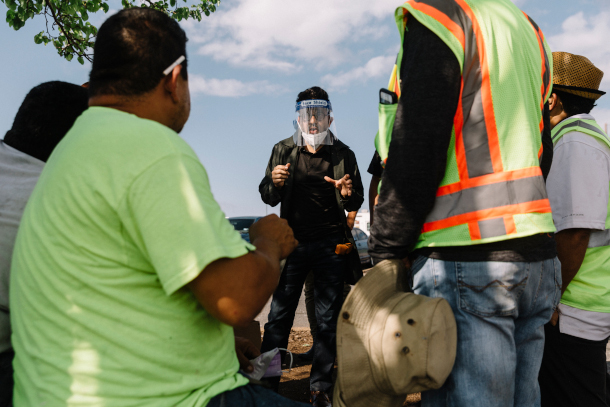
Saket Soni talks to resilience workers during repairs after the 2020 Hurricane Laura. (Photo: Courtesy of Resilience Force)
DOERING: Saket, how bipartisan is the idea of of putting funding towards climate resilience?
SONI: Well, I can tell you this, if you come with me, to an American city or town, hit by disaster, whether it's in Kentucky, where I was in December, after the tornadoes tore through Appalachia or in Louisiana, where two hurricanes in two years, uprooted tens of thousands of families, you know, sent them away from their homes, destroyed their homes and their their livelihoods. In these kinds of communities, climate resilience is an urgent need. And it's not a political conversation. It's bipartisan in the sense that politics doesn't matter. People after disasters, cooperate with each other, they help each other that's an American value. You know, I've seen Republican mayor's ask the police in their towns, to stop checking for documents so that undocumented people can pass through safely and go to their workplaces to rebuild homes. I've seen dinners take place between migrant workers and their US born beneficiaries, the homeowners who own the homes that the workers are fixing. And there are expressions of gratitude on each side. So that's what disaster recovery looks like on the ground. And I've never found a situation where politics trumps the needs of recovery. That's the way it needs to be in Washington. That's the way it needs to be in our national conversation.
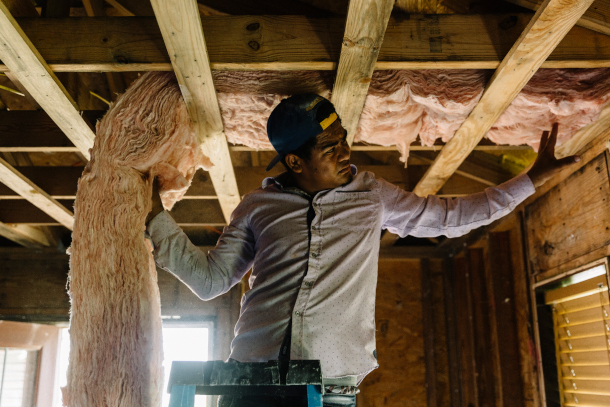
Resilience workers travel across the country chasing disasters with little in the way of federal occupational health and safety protections. (Photo: Courtesy of Resilience Force)
DOERING: Saket Soni is director of Resilience Force. Thank you so much Saket.
SONI: Thank you.
DOERING: By the way the Climate Resilience Workforce Act has yet have a hearing but Congress will need to consider something like this as devastating climate disasters just keep coming.
Related links:
- Learn more about Resilience Force
- Grist ”Undocumented Workers are Cleaning Up Our Climate Disasters. A New Bill Would Protect Them”
- Read the Climate Resilience Workforce Act
- Watch a panel discussion about the Climate Resilience Workforce Act
- Connect with Saket Soni via Twitter
[BIRDNOTE THEME]
BirdNote®: The Sociable Weaver’s Colonial Nest
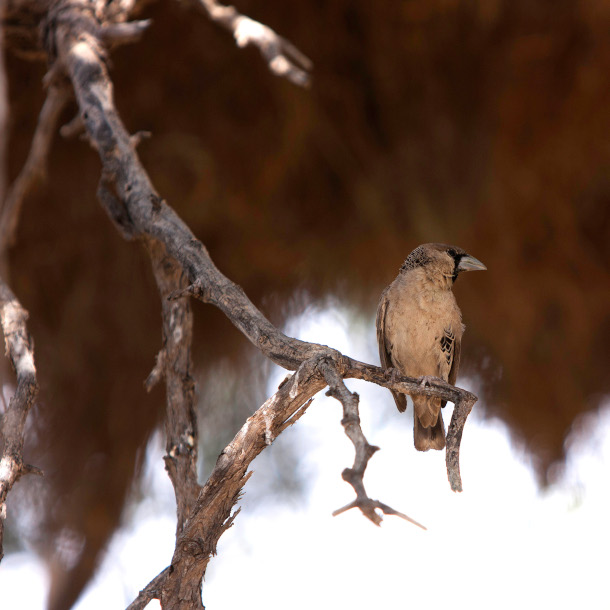
Each bird family has a separate entrance into their own nest within the larger structure. (Photo: Sean van der Westhuizen, Flickr, CC BY-NC-ND 2.0)
CURWOOD: It’s spring time here in the Northern Hemisphere and that means many birds must soon get down to the serious business of nesting. But as BirdNote’s Michael Stein reports, when it comes to building a nest the sociable weaver takes the cake.
BirdNote®
The Sociable Weaver's Colonial Nest
When it comes to nests, common sense would suggest that if you’re a big bird, you build a big one — a small bird, a small one. But in fact, some species of smaller birds build large nests. None, though, build anything like the huge, communal, structures of Sociable Weavers in southern Africa’s arid plains. These House sparrow-sized birds often live in accommodations with room for up to 500 birds.
[http://macaulaylibrary.org/audio/61174, use any parts in background]
Made from stiff grass, they’re relatively cool during the intensely hot day and relatively warm during the very cold night. A colony is made up of hundreds of individual nests clumped together. Attached to acacia trees or utility poles, they look like haystacks suspended above the earth. Each pair or family of Sociable Weavers has its own access hole and tunnel into a chamber within the larger complex.
Some structures have persisted for more than 100 years, with constant occupation by succeeding generations of Sociable Weavers.
One drawback of these nest structures is their weight: up to a ton when dry, even more when wet. They’re so heavy they can break their supporting branches and go crashing to the earth below.
I’m Michael Stein.
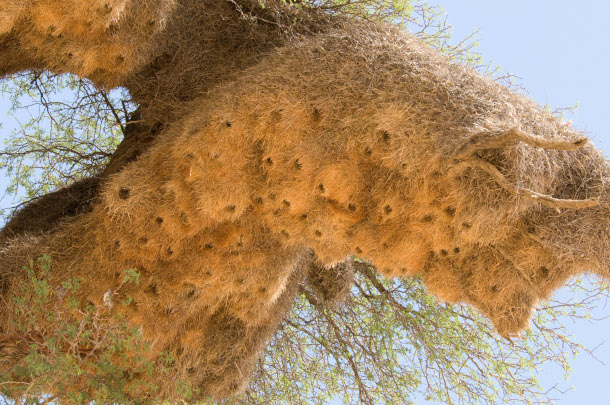
Sociable weavers’ nests, which can last for over a century, are home to generations of bird families. (Photo: Jeppestown, Flickr, CC BY-SA 2.0)
###
Written by Bob Sundstrom
Bird sounds provided by The Macaulay Library of Natural Sounds at the Cornell Lab of Ornithology, Ithaca, New York. Social Weaver [61174] recorded by Linda Macaulay.
BirdNote's theme music was composed and played by Nancy Rumbel and John Kessler.
Producer: John Kessler
Executive Producer: Dominic Black
© 2016 Tune In to Nature.org March 2016 / 2021 Narrator: Michael Stein
ID# SOCWEA-01-2016-03-29 SOCWEA-01
https://www.birdnote.org/listen/shows/sociable-weavers-colonial-nest
CURWOOD: For photos migrate over to the Living on Earth website, loe dot org.
Related links:
- YouTube | ”Weavers Build Huge Communal Nests in Kalahari”
- Audubon | “Africa’s Social Weaverbirds Take Communal Living to the Next Level”
- Learn more about BirdNote®
[MUSIC: Entrain, “Hear That Long Snake Moan,” on Right Away People vol 2 by Entrain]
DOERING: Coming up – Poetry as a way to explore the extinction crisis unfolding around us. That’s just ahead on Living on Earth.
ANNOUNCER: Funding for Living on Earth comes from you, our listeners, and United Technologies, combining passion for science with engineering to create solutions designed for sustainability in aerospace, building industries, and food refrigeration.
[CUTAWAY MUSIC: Miles Davis, “All Blues” on Kind of Blue (Legacy Edition), Columbia Records]
Draining Summer Lake
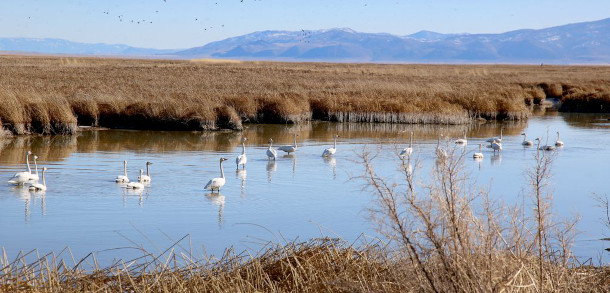
A flock of birds stand in the waters of Summer Lake. (Photo: Emily Cureton Cook, OPB)
CURWOOD: It’s Living on Earth, I’m Steve Curwood.
DOERING: And I’m Jenni Doering
Summer Lake in the high desert of southern Oregon is a critical stop for migratory birds but the springs that feed the lake are at risk of drying up. Oregon Public Broadcasting reporter Emily Cureton Cook has the story.
CURETON COOK: Cool, clean water bubbles up from the ground where Ana Springs begin. This groundwater is the lifeblood of Summer Lake State Wildlife Area. It hosts millions of migratory birds every year.
ST LOUIS: We're right here in the Pacific Flyway. These are the main pathways that birds move north and south across North America.
CURETON COOK: Biologist Marty St. Louis was a state wildlife manager here for over 30 years. He's retired now, but he still lives next door, and he delights in watching the neighbors.
ST LOUIS: Those are tundra swans.
CURETON COOK: Tundra swans.
ST LOUIS: They used to be called whistling swans. These are Coots, American Coots. So this is where the rails live. We have just a handful that spend the wintertime here. Now, here's a pair of sandhill cranes.
[SOUNDS OF BIRDS HONKING]
ST LOUIS: They're just letting you know. And do you see this white out here? Snow geese -- 10 to 15,000 of them.
CURETON COOK: Without groundwater springs, all this would go silent. The lake depends on springs and their extinction is a real threat, says Lisa Brown, and environmental advocate and attorney for the nonprofit WaterWatch.
BROWN: It's alarming that we have a plan in place in Oregon to basically dry up Summer Lake.
CURETON COOK: Brown says the Oregon Water Resources Department has stood by while agricultural wells overdraw the aquifer and drain the springs. The state agency's own data show Ana Springs have been declining steadily ever since people started pumping groundwater to nearby hay farms.
BROWN: That got my attention.
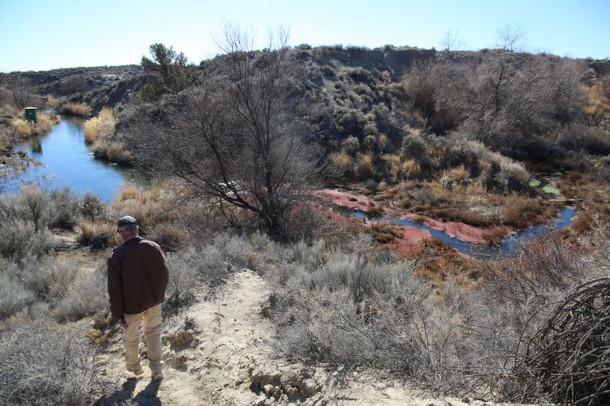
Retired state wildlife manager, Marty St. Louis, walks through prickly desert plants to reach the banks of the Ana river. (Photo: Emily Cureton Cook, OPB)
CURETON COOK: Water Resources Department Deputy Director Doug Woodcock acknowledges that wells in the region are lowering the water table, which very likely contributes to the springs drying. But he denied any intentional plan to favor farmers.
WOODCOCK: That's just the nature of groundwater hydrology.
CURETON COOK: Under already-approved state water rights, farmers motivated by rising hay prices could extract a lot more well water in the future.
WOODCOCK: People grow into their water rights over time. They don't just start immediately using the maximum amount.
CURETON COOK: In the 1980's farms were taking less water. Back then a state scientist predicted that completely draining the main source of Summer Lake would take decades, or it might take a century. More than 30 years later, more water goes to farms. The springs are shrinking, and the state agency that could step in hasn't. It's now focused on parts of Oregon with aquifers that are even more severely overdrawn.
WOODCOCK: The department does have a charge to manage the area sustainably. And as we can get to it, we will.
CURETON COOK: Future regulations will likely pit people who value water for wildlife against those whose communities depend on farming. Dan Jansen is a hay grower who wants to conserve more water and avoid a crackdown on water rights.
JANSEN: If we get cut back here it's going to be devastating. I mean, this will be a ghost town. Nothing but blowing sand here.
CURETON COOK: High winds and harsh weather famously batter his home in Christmas Valley, where few crops will grow. Jansen says these extreme conditions are part of what makes alfalfa hay actually thrive there.
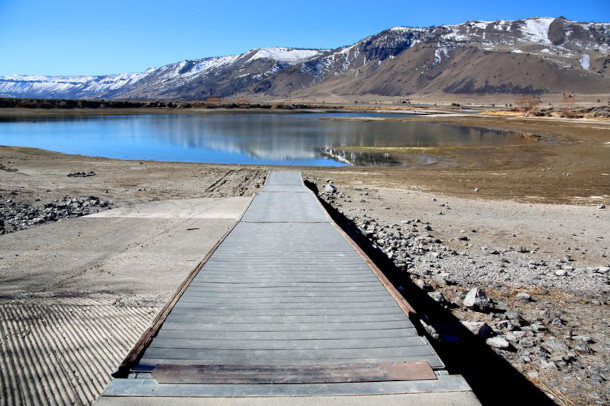
Shrinking water levels at a reservoir over Ana Springs, as groundwater is released to a river channel that feeds Summer Lake State Wildlife Area. (Photo: Emily Cureton Cook, OPB)
JANSEN: This is the best climate, probably in the world, for this crop.
CURETON COOK: He says buyers from Asian countries like China, Japan and South Korea will pay a premium price for Christmas Valley hay.
JANSEN: And now we're starting to get a lot of Middle East countries that are buying because they don't have any water to grow it.
CURETON COOK: Jansen is planning for a future where declining groundwater is going to affect his livelihood. That reality is already starting to show in the wildlife area, says retired manager Marty St. Louis.
ST LOUIS: Right now, it's like a death by a thousand cuts.
CURETON COOK: He worries that wetlands like Summer Lake are disappearing all over the world.
ST LOUIS: We're thinking on, you know, human terms of 50, 100 years. But Mother Nature, I mean, she's thinking on thousands of year intervals.
CURETON COOK: And when compared to a lake that's 10,000 years old, the decades until Ana Springs dry up are only a fleeting moment. I'm Emily Cureton Cook, reporting.
DOERING: Emily’s story comes to us courtesy of Oregon Public Broadcasting.
Related links:
- This story on the OPB Website
- More from Emily Cureton Cook
[MUSIC: Yo-Yo Ma and the Silk Road Ensemble, “Going Home on The Music of Strangers, Sony Masterworks]
‘Dear Specimen’: Poetry for the Extinction Crisis
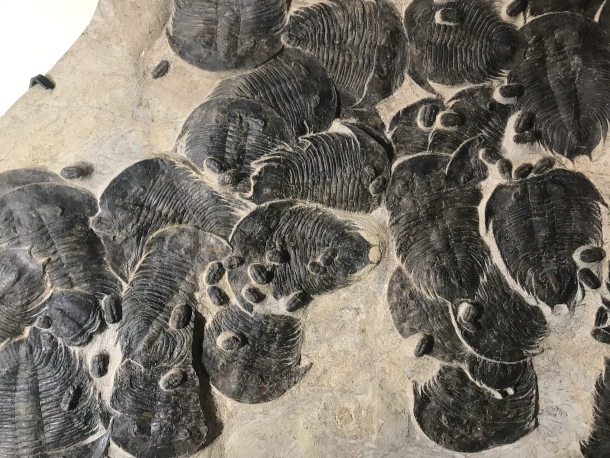
Fossil trilobites at the Zuhl Museum at New Mexico State University (Photo: W. J. Herbert)
DOERING: April is Poetry Month and we’re kicking it off with a collection of poems that peers deep into the past at species long gone to grapple with the extinctions unfolding today. “Dear Specimen” by W.J. Herbert examines the extinction crisis through the eyes of a woman who is facing her own death after a terminal diagnosis. But now, rest assured the speaker in the poems is an invented persona and the author herself is alive and well. W.J. Herbert joins me now from Portland, Maine. Welcome to Living on Earth!
HERBERT: Thank you, Steve. I'm glad to be here.
CURWOOD: It's our pleasure. Now many of your poems are in the form of well, let's say it's a one-sided conversation that your speaker is having with fossils and other specimens in a museum. So what inspired this?
HERBERT: Well, the true muse of this collection was the 2016 presidential election, when Trump pulled us out of the Paris Climate Accords, when he began dismantling all the hard-won victories environmental activists and policymakers had fought for, and I felt despair. And on a trip to New Mexico, Las Cruces I'd stumbled upon the Zuhl Museum. And there, fossils of 500-million year old species, extinct species, were displayed beside the few whose descendants survive. And it's at that point that the magnitude of the loss we face really hit me. Those animals, many of them died in the Permian extinction, which took 96% of our marine species and maybe 94% of our terrestrial. And it seemed to me that we were facing this kind of loss, and that we're culpable. And so that's where many of the poems began.

Dear Specimen is a 2020 National Poetry Series winner. (Image: Courtesy of Beacon Press)
CURWOOD: So let's go right to the poetry along the lines of what you've been talking about. I'm thinking of the poem Nautiloid. This is one of these poems where the speaker is directly talking to a fossil. Tell us about the nautiloid creature and, and read the poem for us, please.
HERBERT: Well, the nautiloid that I'm addressing in this poem was the straight-shelled nautiloid, very prolific in the Ordovician, and all the way up until the Permian. And there is an epigraph for this poem:
"Of the 2500 species that evolved in warm, shallow seas, only six survive."
It's called, "Nautiloid."
[READING]
Little squid, you're swimming
as if this black granite
only seconds ago skeined you,
though you haven't siphoned
through your fleshy tube
in 400 million years.
How is it you're still glistening?--
as if reflecting the same sunlight
I felt this morning
as I walked through your sea bed.
It's a desert, now, for coyote
& scavenging rabbit, occasional
jogger with her dog. all the green
-leaved creosote
scorched stones & gravel can gather.
CURWOOD: W.J., tell me, how does the speaker's own terminal illness affect the way that she's looking at these ancient fossils, do you think?
HERBERT: Well, I think the book is making two parallel journeys. The speaker is trying to understand her own personal mortality. But the fossil poems more refer to our species extinction. I think that the specimen poems are the ones where she feels closer, and she is able to notice the minutiae of them. The fossils are so stark, so bare, that I think that she much more easily can look at the specimens that she sees in this collection. And some of the poems are also written about animals that she sees in her environment. And those are the ones that she believes may be able to maybe not help her understand her impending death, but at least help her to understand what it means to be alive.
A tern specimen at the North Carolina Museum of Natural Sciences Discovery Room that inspired the poem “Least Tern” in Dear Specimen (Photo: W. J. Herbert)
CURWOOD: So you could say that this collection is an ode to extinct species. But then on the other hand, maybe you could say it's celebrating them. So tell me though, what is it about these fossils that just so fascinates you and inspire so much wonder?
HERBERT: Well, when you realize how various life was, before we got to this planet, the millions of species that existed before we did, you just have to marvel at their miraculous adaptations, and their beauty in the way they coped with their environment. For example, with the nautiloid, the species that this poem was written about doesn't exist anymore. And all of the very many nautiloid species have virtually disappeared, there is only one left in our present day that you can see. And that's the chambered nautilus, and the fact that this animal was able to adapt by sinking lower in a sea that was becoming increasingly acidic, where oxygen wasn't available. And so the nautiloid in the poem became extinct, but the chambered nautilus survived. And so I was asking questions about survival. Though, it seems like the kind of chaos that we are creating with our fossil fuel extraction and burning is going to create a world where no adaptation will be enough to allow much survival of species. And so by looking at fossils, I can see the deep time reflected in the past, and moving forward in the future, I fear for the loss we face.
CURWOOD: I'd like you to read one of your poems that in my view is very clear and direct about talking about the climate crisis. You call it Tipping Point. Could you read that one, please?
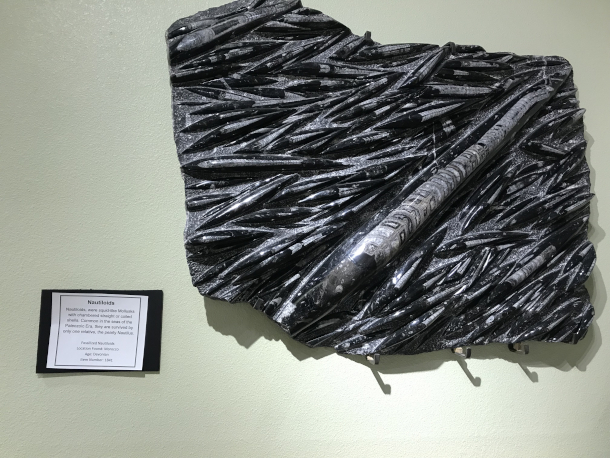
Nautiloid fossils at the Zuhl Museum, New Mexico State University – the inspiration for W. J. Herbert’s poem “Nautiloid” (Photo: W. J. Herbert)
HERBERT: This poem has an epigraph by Greta Thunberg. She spoke at the UN Climate Action Summit in September of 2019. It's a famous quote, she said, "If you choose to fail us, I say we will never forgive you.”
Tipping Point
Fierce heat waves, wildfires, climate refugees,
acidic coral, glacial melt, and look--
a marmoset, orb weaver's filigree,
an algae-coated sloth whose canopy's
on fire, though she gave birth last night. Her nook
inside a lush Brazilian tree
which one sequestered carbon, helped us breathe,
is burning. We've done little to unhook
Earth from this carbon juggernaut, the greed
of fossil fuel producers, energy
that's not renewable, and so you took
your protest to the streets of Karachi,
Cape Town, New York, Bangkok, Berlin, Sydney.
Time's short, you say. From gorge to overlook,
Earth's angry, now, no longer on her knees
and, still, we decimate with each degree:
black rhino, blue whale, leatherback, chinook.
No rainbow, just a grim trajectory.
Marvels archived in dust's dissympathy.
CURWOOD: The climate crisis and the extinction crisis, these things are just so daunting, W.J.; I mean, if one is aware, one must feel some anxiety and grief. So, so how do we not turn away from all this grief and anxiety, and in your view, why is that important?
HERBERT: Well, I think it is true that many of us have a sort of climate PTSD at this point. It's deeply ingrained in us at this point. And for those who are working hard to try to ameliorate this situation, and I'm talking now about this marvelous youth movement that's global, and the many activists who've worked for decades. These people, I feel that they are hungry for a kind of literature, or art, or lived experience that will bring them peace. Yes, we have to keep the climate crisis in the front of our minds so that we can all act together to solve these problems. But at the same time, we need to be calmed. We need to be able to settle down and slow our heartbeats down and open our hearts to receive the kind of calming reassurance that poetry and novels and other kinds of art can can provide for us.
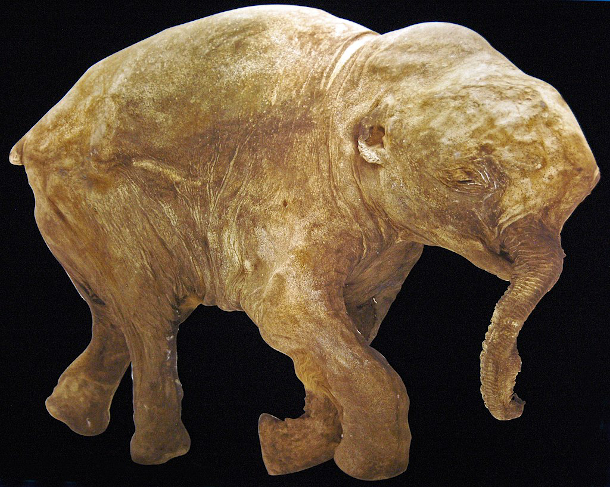
One of the poems in the Dear Specimen collection is titled “Lyuba” after the c. 42,000-year-old baby woolly mammoth specimen unearthed in Siberia in 2007. (Photo: James St. John, Wikimedia Commons, CC BY 2.0)
CURWOOD: It's interesting that in your collection, you openly seek to console the reader. I'm thinking of the poem titled, "After His Nightmare, Sarah Asks." Now Sarah is the daughter of the speaker in this collection, and her young son Seth has just had a nightmare. So Sarah asks her mother to tell Seth a soothing bedtime story. And spoiler alert, it's about manatees. Could you read that for us, please?
HERBERT: Sure, I want to say about manatees, that they are endangered, the species that I'm writing about here, the West Indian Manatee, but they're a peaceful creature that, they're nicknamed sea cows. They graze eight hours a day just below the surface, so their bones are solid, they have to be able to stay submerged. So this poem is midway through the collection. The speaker's daughter's name is Sarah, and she's had a baby. And the boy's name is Seth and he sometimes has nightmares. And so she's calling her mother, asking her mother to tell a bedtime story to Seth. It's called, "After His Nightmare, Sarah Asks."
[READING]
Will you tell him a bedtime story?
"Once a manatee and her calf swam
in a lagoon where herons and egrets feed..."
"What do they eat?" he asks.
"Manatees eat sea grass,
but the calf is so young that it suckles
its mother, and once there was a boy
who, paddling his kayak,
would watch water lap over their great
gray backs."
Seth's quiet. Before he was born,
Sarah, heavy-boned, seemed to float,
undulating
to ebbs and swells as if the moon,
too, was impatient for a baby.
Now via Skype,
I see them snuggling. Above his bed,
a dangling sun. Venus. Mars.
Earth so adrift in the dark,
Seth seems uneasy
beneath it. Does he imagine fevered
soil, poisoned sea grass?
Mom, finish the story!
"I don't know how it ends, Sarah,"
I say, "but the boy loves
the manatees' whiskered faces,
flippers tipped with fingernails,
like his,
and he wonders if the calf
feels as drowsy as he does,
and where
the tide's cradle will carry them."
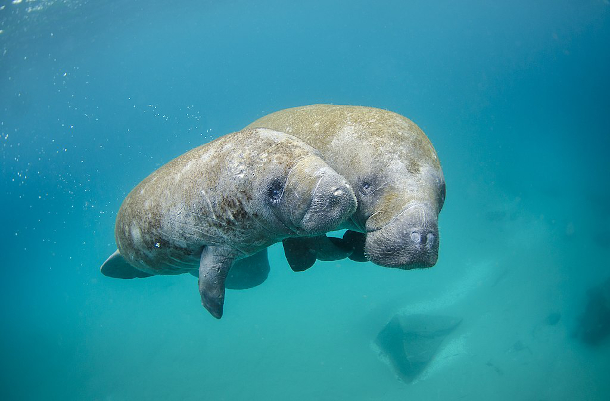
A mother manatee and her calf (Photo: Sam Farkas, NOAA Photo Library, public domain)
CURWOOD: As we wrap up here, it seems to me that the poems in "Dear Specimen" do all revolve around the central question of, well, how much do we deserve as a species to survive? What do you think?
HERBERT: That's a very tough question. We have this gruesome history as a species of hunting others on this planet to extinction. For example, the Steller's sea cow, which is like the manatee; it was larger, gentle, and was hunted to extinction in the 1800s. We have a very destructive legacy on our planet. So the only thing in my mind that we can put forth as an argument as to why we should continue to exist on this planet are our humility, and our empathy, and our love. These qualities, I think, are ones that, that redeem us in a way.
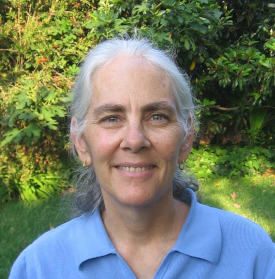
Author W. J. Herbert (Photo: Peter Ackoff)
I also want to say that, I want to put us into context. We are the only extant species in our genus, everyone else in our genus is gone. And in our family, there are only eight extant great ape species. So we're a small part of the world's millions of animal species. And we Homo sapiens sometimes remove ourselves from the natural world in a way that prevents us from feeling deeply and experiencing the world of others. And by others, I not only mean other people, whose experiences are so different, but I mean other species, who bring richness and biodiversity and really contribute to the web of life on our planet that none of us can live without. We need them all.
CURWOOD: W.J. Herbert's book of poetry "Dear Specimen" received a 2020 National Poetry Series Award. Thanks so much for taking the time with us today.
HERBERT: Thank you, Steve. It's been a pleasure.
Related links:
- Find the poetry collection Dear Specimen here (Affiliate link helps donate to LOE and local indie bookstores)
- W. J. Herbert’s website
[MUSIC: Yo-Yo Ma, “Bach Cello Suite No 6 in D Major” at the BBC Prom 2015]
CURWOOD: Living on Earth is produced by the World Media Foundation. Our crew includes Naomi Arenberg, Bobby Bascomb, Paloma Beltran, Chloe Chen, Iris Chen, Josh Croom, Gabriella Diplan, Mark Kausch, Mark Seth Lender, Don Lyman, Louis Mallison, Aynsley O’Neill, Sophia Pandelidis, Jake Rego, Teresa Shi, and Jolanda Omari.
DOERING: Tom Tiger engineered our show. Alison Lirish Dean composed our themes. You can hear us anytime at L-O-E dot org, Apple Podcasts and Google Podcasts, and like us, please, on our Facebook page - Living on Earth. We tweet from @livingonearth. And find us on Instagram at livingonearthradio. I’m Jenni Doering
CURWOOD: And I’m Steve Curwood. Thanks for listening!
ANNOUNCER: Funding for Living on Earth comes from you, our listeners, and from the University of Massachusetts, Boston, in association with its School for the Environment, developing the next generation of environmental leaders. And from the Grantham Foundation for the protection of the environment, supporting strategic communications and collaboration in solving the world’s most pressing environmental problems.
ANNOUNCER 2: PRX.
Living on Earth wants to hear from you!
Living on Earth
62 Calef Highway, Suite 212
Lee, NH 03861
Telephone: 617-287-4121
E-mail: comments@loe.org
Newsletter [Click here]
Donate to Living on Earth!
Living on Earth is an independent media program and relies entirely on contributions from listeners and institutions supporting public service. Please donate now to preserve an independent environmental voice.
NewsletterLiving on Earth offers a weekly delivery of the show's rundown to your mailbox. Sign up for our newsletter today!
 Sailors For The Sea: Be the change you want to sea.
Sailors For The Sea: Be the change you want to sea.
 The Grantham Foundation for the Protection of the Environment: Committed to protecting and improving the health of the global environment.
The Grantham Foundation for the Protection of the Environment: Committed to protecting and improving the health of the global environment.
 Contribute to Living on Earth and receive, as our gift to you, an archival print of one of Mark Seth Lender's extraordinary wildlife photographs. Follow the link to see Mark's current collection of photographs.
Contribute to Living on Earth and receive, as our gift to you, an archival print of one of Mark Seth Lender's extraordinary wildlife photographs. Follow the link to see Mark's current collection of photographs.
 Buy a signed copy of Mark Seth Lender's book Smeagull the Seagull & support Living on Earth
Buy a signed copy of Mark Seth Lender's book Smeagull the Seagull & support Living on Earth

